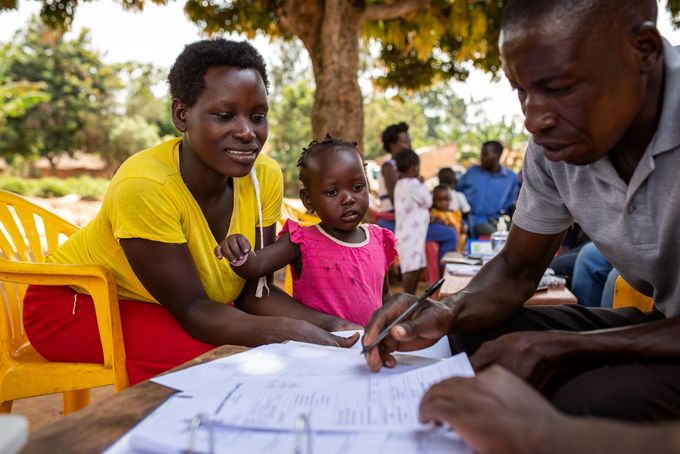The Pediatric Praziquantel Consortium has achieved a significant milestone with the first administration of its new pediatric treatment to a preschool-aged child in Uganda. The new drug, designed specifically for children aged three months to six years, addresses a long-standing treatment gap for schistosomiasis, a parasitic disease affecting millions of children in sub-Saharan Africa. Swiss TPH has been a member of the consortium since its start, conducted the clinical trials and is now co-leading the programme to introduce the drug in endemic countries.

A pre-school girl receives treatment as part of the first treatment delivery of the new pediatric medication in Bugiri District in Uganda. Photo credit: Kibuuka Makisa/Candid Local
The new pediatric treatment has been developed by the Pediatric Praziquantel Consortium, the first international, public-private partnership in schistosomiasis, and the only partnership targeting the preschool age range. It is the first-ever pediatric treatment designed specifically for preschool-aged children, closing a critical gap in the fight against schistosomiasis.
Swiss TPH has been part of the consortium from the very beginning and has conducted clinical trials in Tanzania, Côte d'Ivoire and Kenya. Today, it is co-leading the programme to introduce the drug to endemic countries.
A solution to a critical health challenge
Schistosomiasis, also known as bilharzia, affects an estimated 250 million people worldwide, including approximately 50 million preschool-aged children, mainly in sub-Saharan Africa. The disease can lead to malnutrition, anemia, stunted growth, and cognitive impairment. In extreme cases, it causes chronic organ damage or death. Until now, a child-friendly treatment specifically tailored for preschool-aged children was not available, leaving millions of preschoolers at risk. According to the WHO guideline for the control and elimination of schistosomiasis, children aged two years and older should be included in preventive chemotherapy for schistosomiasis.
New treatment
The new pediatric treatment, a 150 mg dispersible tablet, is child-friendly, palatable, and stable in tropical climates, making it ideal for endemic regions. It has received a positive scientific opinion from the European Medicines Agency (EMA) and is included in the World Health Organization’s (WHO) List of Prequalified Medicines, with its addition to the WHO Essential Medicines List anticipated in 2025.
“We are proud to have reached this critical milestone,” said Peter Steinmann, public health specialist at Swiss TPH and co-lead of the Consortium's ADOPT programme. “By addressing the medical needs of preschool-aged children, we are aiming to fulfill a significant treatment gap, contributing to the fight against schistosomiasis.”
Impact on public health
Treating preschool-aged children is essential to lowering the disease burden on individuals and public health systems. Early intervention prevents complications, possibly reducing the need for costly medical care later in life. It also improves educational outcomes and long-term productivity, potentially generating cost savings in affected countries.
“As the first country to introduce the new pediatric treatment to children under five, Uganda has reached a historic milestone, expanding access to a group that has never previously benefited from treatment,” said Prudence Beinamaryo, Programme Manager of the Bilharzia and Worm Control at the Ministry of Health Uganda.
Hilda Kyarisiima, Senior Medical Officer and ADOPT Programme Principal Investigator at the Ministry of Health in Uganda added: “Lessons from these first treatments in Uganda will inform future scale-up and significantly contribute to achieving the schistosomiasis targets outlined in the WHO NTD Roadmap 2030.”
First treatment roll-out and next steps
The first treatment was administered in Uganda as part of the Consortium’s ADOPT programme, an implementation research study that focuses on the integration of the new medication into existing healthcare platforms. The treatment is being introduced through the country’s NTD Mass Drug Administration Platform. The overall aim of the ADOPT study is to prepare for the widespread introduction of the drug in schistosome-endemic communities. Beyond Uganda, the introduction of the drug will be extended to other sub-Saharan African countries, starting with Côte d’Ivoire, Kenya, Tanzania, and Senegal.
Global collaboration and sustainable access
The Consortium is working in close collaboration with local ministries of health and global partners to facilitate equitable and sustainable access to the new pediatric treatment. It will be available on an at-cost basis in sub-Saharan African countries, supporting long-term, sustainable health outcomes. This effort contributes to the elimination of schistosomiasis as a public health problem and thereby also the United Nations’ Sustainable Development Goals (SDGs), in particular SDGs 3 (Good Health and Wellbeing) and 17 (Partnerships for the Goals).
